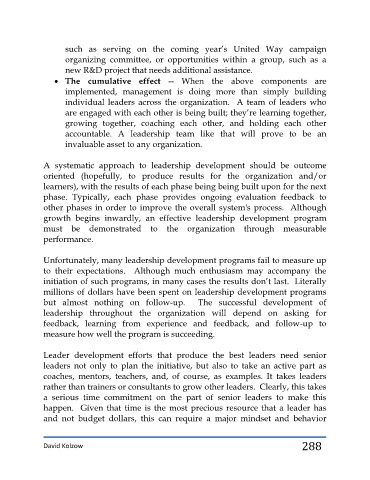Page 288 - 4- Leading_from_Within
P. 288
such as serving on the coming year’s United Way campaign
organizing committee, or opportunities within a group, such as a
new R&D project that needs additional assistance.
• The cumulative effect -- When the above components are
implemented, management is doing more than simply building
individual leaders across the organization. A team of leaders who
are engaged with each other is being built; they’re learning together,
growing together, coaching each other, and holding each other
accountable. A leadership team like that will prove to be an
invaluable asset to any organization.
A systematic approach to leadership development should be outcome
oriented (hopefully, to produce results for the organization and/or
learners), with the results of each phase being being built upon for the next
phase. Typically, each phase provides ongoing evaluation feedback to
other phases in order to improve the overall system's process. Although
growth begins inwardly, an effective leadership development program
must be demonstrated to the organization through measurable
performance.
Unfortunately, many leadership development programs fail to measure up
to their expectations. Although much enthusiasm may accompany the
initiation of such programs, in many cases the results don’t last. Literally
millions of dollars have been spent on leadership development programs
but almost nothing on follow-up. The successful development of
leadership throughout the organization will depend on asking for
feedback, learning from experience and feedback, and follow-up to
measure how well the program is succeeding.
Leader development efforts that produce the best leaders need senior
leaders not only to plan the initiative, but also to take an active part as
coaches, mentors, teachers, and, of course, as examples. It takes leaders
rather than trainers or consultants to grow other leaders. Clearly, this takes
a serious time commitment on the part of senior leaders to make this
happen. Given that time is the most precious resource that a leader has
and not budget dollars, this can require a major mindset and behavior
David Kolzow 288

